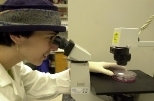MIT researchers and colleagues have found a potentially unlimited source of human cells that could be used to grow engineered blood vessels for the treatment of heart disease and related problems.
For the first time, the researchers showed that human embryonic stem cells can develop into the endothelial cells that make up blood vessels. They then isolated these endothelial cells and showed that they form vessel-like structures both in a culture dish and in a living animal.
The work was announced March 26 in the online edition of the Proceedings of the National Academy of Sciences.
"Blood vessels derived from stem cells could ultimately replace vessels transplanted from one part of the body to another, the current technique used in many operations," said Robert Langer, the Germeshausen Professor of Chemical and Biomedical Engineering and an author of the paper.
"This is the very, very first step toward using embryonic stem cells as a source of endothelial cells for tissue engineering," said Shulamit Levenberg, first author of the paper and a postdoctoral associate in the Department of Chemical Engineering. Her co-authors are Langer; Justin Golub, who was a visiting student from Tufts University when he collaborated on the work; and Michal Amit and Joseph Itskovitz-Eldor of the Technion in Israel.
Human embryonic stem cells have the potential to differentiate into a variety of specialized cells. As a result, they "may be useful as a source of cells for transplantation or tissue engineering," the team wrote. That source of cells potentially could be unlimited because researchers can grow the cells in quantity in the lab.
However, researchers have found it difficult to isolate cells of a specific type and characterize them. This has been done with nerve cells (using techniques different from those in the current work), but until now other cell types have resisted such manipulation.
This new technique, however, turned out to be "relatively simple," the researchers report. They were able to "obtain a pure culture of endothelial cells from human embryonic stem cells" that "allowed us to culture large numbers of human embryonic endothelial cells that can be grown in culture without losing endothelial characteristics," they wrote.
STEPS TO GROWING VESSELS
The technique first involved placing the embryonic stem cells in suspension where they formed "embryoid bodies," or aggregates of cells. There they start differentiating into various cell types.
By analyzing these aggregates for genes specific to endothelial cells, "We found that some really did differentiate into endothelial cells," said Levenberg. The team then isolated the endothelial cells from the mixture of all embryoid bodies, grew them on tissue-culture plates, and checked characteristics, such as whether they formed tube-like structures, to determine if they met the definition of endothelial cells.
After a thumbs-up for that test, the team proceeded to see if the cells might have therapeutic potential. "We wanted to see if they would form vessel-like structures in a living animal," Levenberg said.
So in a technique pioneered by Langer, they "seeded" the cells on tiny biodegradable plastic scaffolds that provide a structure for them to grow on, then implanted them in mice with suppressed immune systems (to prevent rejection).
When the scaffolds were removed a few weeks later, the cells had indeed formed vessel-like structures. The team even saw some mice blood cells in the structures, indicating that they were "becoming functional blood-carrying microvessels."
In conclusion, the researchers wrote, "This study indicates that human embryonic stem cells ... can spontaneously differentiate into the endothelial lineage, ultimately forming vascular structures."
The work was supported by unrestricted gifts to the Langer laboratory and by the European Molecular Biology Organization.
A version of this article appeared in MIT Tech Talk on April 3, 2002.







